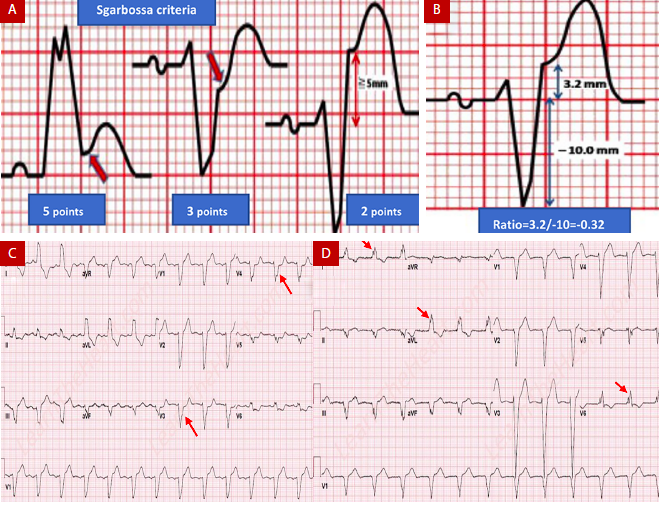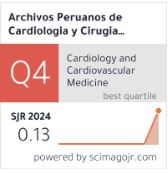Patrones electrocardiográficos de alto riesgo en pacientes con síndrome coronario agudo
DOI:
https://doi.org/10.47487/apcyccv.v1i4.82Palabras clave:
infarto de miocardio, electrocardiografíaResumen
El infarto agudo de miocardio es la principal causa de muerte en el mundo, y el electrocardiograma sigue siendo la herramienta diagnóstica para determinar un infarto agudo de miocardio con elevación del segmento ST. A pesar de ello, solo la mitad de los pacientes presenta hallazgos clásicos en el electrocardiograma, compatibles con los criterios de infarto con elevación del ST. Existe un espectro de hallazgos electrocardiográficos que pueden reflejar un fenómeno de oclusión coronaria aguda, el cual debe ser prontamente reconocido por el clínico para ofrecer una terapia de reperfusión temprana.
Descargas
Referencias
O’Gara PT, Kushner FG, Ascheim DD et al. 2013 ACCF/AHA guideline for the management of ST-elevation myocardial infarction: executive summary: a report of the American College of Cardiology Foundation/American Heart Association Task Force on Practice Guidelines. J Am Coll Cardiol. 2013 Jan 29;61(4):485–510. DOI: 10.1002/ccd.24776
Li RA, Leppo M, Miki T, et al. Molecular basis of electrocardiographic ST-segment elevation. Circ Res. 2000 Nov 10;87(10):837–9. DOI: 10.1161/01.res.87.10.837
Ibanez B, James S, Agewall S, et al. 2017 ESC Guidelines for the management of acute myocardial infarction in patients presenting with ST-segment elevation: The Task Force for the management of acute myocardial infarction in patients presenting with ST-segment elevation of the European Society of Cardiology (ESC). Eur Heart J. 2018 07;39(2):119–77. DOI: 10.1093/eurheartj/ehx393
Brady WJ, Roberts D, Morris F. The nondiagnostic ECG in the chest pain patient: normal and nonspecific initial ECG presentations of acute MI. Am J Emerg Med. 1999 Jul;17(4):394–7. DOI: 10.1016/s0735-6757(99)90095-5.
Macias M, Peachey J, Mattu A, et al. The electrocardiogram in the ACS patient: high-risk electrocardiographic presentations lacking anatomically oriented ST-segment elevation. Am J Emerg Med. 2016 Mar;34(3):611–7. DOI: 10.1016/j.ajem.2015.11.047.
Levin DC, Harrington DP, Bettmann MA, et al. Anatomic variations of the coronary arteries supplying the anterolateral aspect of the left ventricle: possible explanation for the “Unexplained” anterior aneurysm. Invest Radiol. 1982 Oct;17(5):458–62.
de Winter RJ, Verouden NJW, Wellens HJJ, et al. Interventional Cardiology Group of the Academic Medical Center. A new ECG sign of proximal LAD occlusion. N Engl J Med. 2008 Nov 6;359(19):2071–3. DOI: 10.1097/00004424-198209000-00004.
Verouden NJ, Koch KT, Peters RJ, et al. Persistent precordial “hyperacute” T-waves signify proximal left anterior descending artery occlusion. Heart Br Card Soc. 2009 Oct;95(20):1701–6. DOI: 10.1136/hrt.2009.174557.
de Winter RW, Adams R, Amoroso G, et al. Prevalence of junctional ST-depression with tall symmetrical T-waves in a pre-hospital field triage system for STEMI patients. J Electrocardiol. 2019 Feb;52:1–5. DOI: 10.1016/j.jelectrocard.2018.10.092
de Zwaan C, Bär FW, Wellens HJ. Characteristic electrocardiographic pattern indicating a critical stenosis high in left anterior descending coronary artery in patients admitted because of impending myocardial infarction. Am Heart J. 1982 Apr;103(4 Pt 2):730–6. DOI: 10.1016/0002-8703(82)90480-x.
de Zwaan C, Bär FW, Janssen JH, et al. Angiographic and clinical characteristics of patients with unstable angina showing an ECG pattern indicating critical narrowing of the proximal LAD coronary artery. Am Heart J. 1989 Mar;117(3):657–65. DOI: 10.1016/0002-8703(89)90742-4.
Rostoff P, Piwowarska W, Gackowski A, et al. Electrocardiographic prediction of acute left main coronary artery occlusion. Am J Emerg Med. 2007 Sep;25(7):852–5. DOI: 10.1016/j.ajem.2007.01.025.
Knotts RJ, Wilson JM, Kim E, et al. Diffuse ST depression with ST elevation in aVR: Is this pattern specific for global ischemia due to left main coronary artery disease? J Electrocardiol. 2013 Jun;46(3):240–8. DOI: 10.1016/j.jelectrocard.2012.12.016.
Yan AT, Yan RT, Kennelly BM, et al. Relationship of ST elevation in lead aVR with angiographic findings and outcome in non-ST elevation acute coronary syndromes. Am Heart J. 2007 Jul;154(1):71–8. DOI: 10.1016/j.ahj.2007.03.037.
Bayés de Luna A. [New heart wall terminology and new electrocardiographic classification of Q-wave myocardial infarction based on correlations with magnetic resonance imaging]. Rev Esp Cardiol. 2007 Jul;60(7):683–9. DOI: 10.1157/13108272
Thygesen K, Alpert JS, Jaffe AS, et al. Fourth universal definition of myocardial infarction (2018). Eur Heart J. 2019 Jan 14;40(3):237–69. DOI:10.1093/eurheartj/ehy462
Levis JT. ECG Diagnosis: Isolated Posterior Wall Myocardial Infarction. Perm J. 2015;19(4):e143-144. DOI: 10.7812/tpp/14-244
Matetzky S, Freimark D, Feinberg MS, et al. Acute myocardial infarction with isolated ST-segment elevation in posterior chest leads V7-9: “hidden” ST-segment elevations revealing acute posterior infarction. J Am Coll Cardiol. 1999 Sep;34(3):748–53. DOI: 10.1016/s0735-1097(99)00249-1
Di Chiara A. Right bundle branch block during the acute phase of myocardial infarction: modern redefinitions of old concepts. Eur Heart J. 2006 Jan;27(1):1–2. DOI: 10.1093/eurheartj/ehi552.
Kleemann T, Juenger C, Gitt AK, et al. Incidence and clinical impact of right bundle branch block in patients with acute myocardial infarction: ST elevation myocardial infarction versus non-ST elevation myocardial infarction. Am Heart J. 2008 Aug;156(2):256–61. DOI: 10.1016/j.ahj.2008.03.003.
Wang J, Luo H, Kong C, et al. Prognostic value of new-onset right bundle-branch block in acute myocardial infarction patients: a systematic review and meta-analysis. PeerJ. 2018;6:e4497. DOI: 10.7717/peerj.4497
Liakopoulos V, Kellerth T, Christensen K. Left bundle branch block and suspected myocardial infarction: does chronicity of the branch block matter? Eur Heart J Acute Cardiovasc Care. 2013 Jun;2(2):182–9. DOI: 10.1177/2048872613483589.
Shlipak MG, Lyons WL, Go AS, et al. Should the electrocardiogram be used to guide therapy for patients with left bundle-branch block and suspected myocardial infarction? JAMA. 1999 Feb 24;281(8):714–9. DOI: 10.1001/jama.281.8.714.
Sgarbossa EB, Pinski SL, Barbagelata A, et al. Electrocardiographic diagnosis of evolving acute myocardial infarction in the presence of left bundle-branch block. GUSTO-1 (Global Utilization of Streptokinase and Tissue Plasminogen Activator for Occluded Coronary Arteries) Investigators. N Engl J Med. 1996 Feb 22;334(8):481–7. DOI: 10.1056/NEJM199602223340801.
Tabas JA, Rodriguez RM, Seligman HK, et al. Electrocardiographic criteria for detecting acute myocardial infarction in patients with left bundle branch block: a meta-analysis. Ann Emerg Med. 2008 Oct;52(4):329-336.e1. DOI: 10.1016/j.annemergmed.2007.12.006.
Smith SW, Dodd KW, Henry TD, et al. Diagnosis of ST-elevation myocardial infarction in the presence of left bundle branch block with the ST-elevation to S-wave ratio in a modified Sgarbossa rule. Ann Emerg Med. 2012 Dec;60(6):766–76. DOI: 10.1016/j.annemergmed.2012.07.119.


















